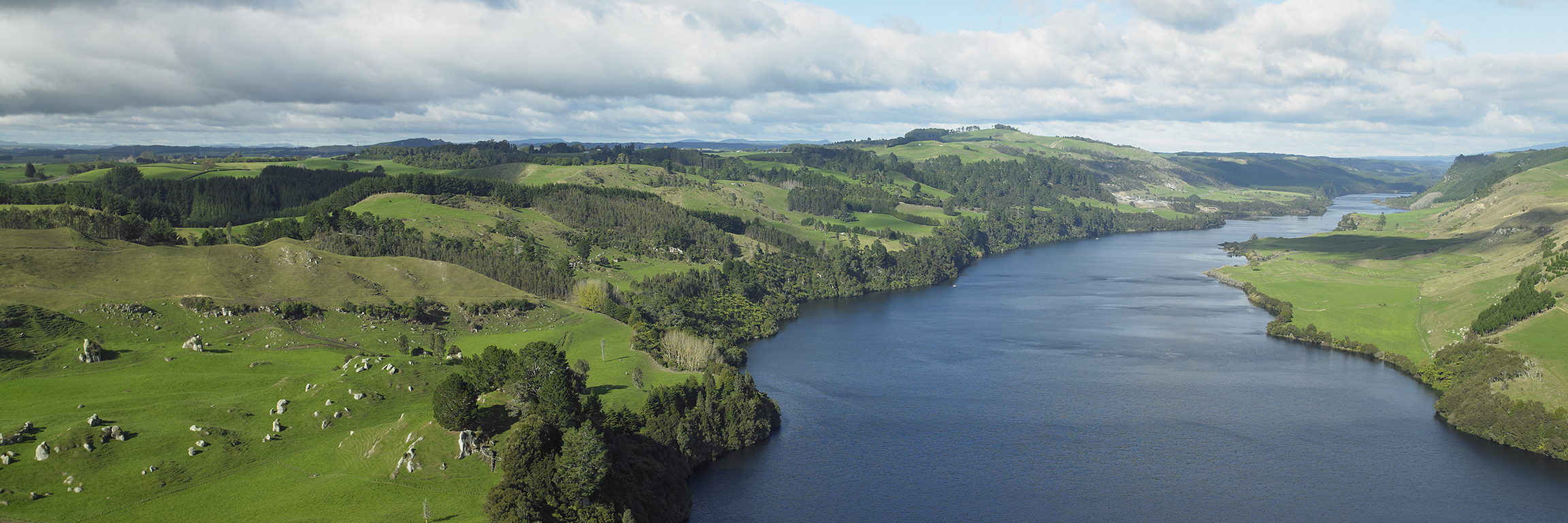The Waikato River
The tribes of the Waikato River are river people - generations of Waikato Māori have lived close to the river and it is deeply important to them. The Waikato River is a tupuna (ancestor), a taonga (treasure), and the mauri (life force) of Tainui Waka and Ngāti Tūwharetoa.
Waikato taniwharau
He piko he taniwha, he piko he taniwha
Waikato of a hundred chiefs, on every bend a taniwha (chief).
Days gone by
In the past, Māori used the Waikato River in its entirety. It provided for spiritual and material needs, food, a source of cleansing and healing and a network for trade, travel and communication. An abundance of food such as tuna (eel), inanga (whitebait), kōura (freshwater crayfish), kanae (mullet), waterfowl, and wild vegetables were harvested from the river and associated swamps and tributaries.
In 1859 the Austrian geologist Ferdinand von Hochstetter travelled up the Waikato River and recorded the following observations:
"The impression made by the sight of the majestic stream is truly grand. It is only with the Danube or the Rhine that I can compare the mighty river which we had just entered. It is the principal river in the North Island….it surpasses all others…. Its waters roll through the most fertile and most beautiful fields, populated by numerous and most powerful tribes of the natives, who have taken their name from it….They look upon the Waikato more than upon any other river of New Zealand as being exclusively their own…. Never up to the time of my journey had a boat of European construction been known to float upon the proud native stream."
The source of the Waikato River is the Tongariro National Park, gifted to the nation in 1887 by Paramount Chief Tukino Te Heuheu of Ngāti Tūwharetoa. The tributaries that run from the sacred mountain Tongariro and the Tongariro River are sometimes viewed as part of the Waikato River.
Tribal history and archaeological remains provide evidence of Māori occupation, such as pa sites and cultivation areas, along the length of the River. Some of the significant features of the Waikato River today include:
- Huka Falls
- the geothermal activity and lakes associated with the river
- Tūrangawaewae Marae at Ngāruawāhia
- Taupiri mountain
- Rangiriri
- the mouth of the river (Te Puaha o Waikato).
A powerful healer and food provider
The river has long been used for healing illnesses, the cleansing of the dead, the baptism of new-borns, spiritual cleansing and preparing those who had important tasks to perform or journeys to undertake.
Today the tribes of the Waikato River still seek the healing powers of the water and the blessings from their tupuna – the Waikato River. At times of trouble Māori people gather to rejuvenate their spirit by patting the river surface to invoke the ancestors and sprinkling themselves with the water facing the rising sun.
Marae along the Waikato River have always been renowned for their ability to supply the tables of their hui with a variety of kai from the river. Their mana is, to an extent, reliant on this ability.
However, the river tribes feel that ability has slowly diminished. Elders recall a time of abundant fish harvesting, when the porohe (Stokells smelt), matamata (whitebait) and other freshwater fish were plentiful, whitebait shoals were large and it was not uncommon to pull up a net and discover a whole school of mullet. Kahawai were caught on hand lines and eels were caught in hand nets. Now there are only small quantities of food and plants to harvest.
The river’s health
The tribes of the Waikato River have long considered that the river is ill. Many of their elders report noticeable changes over the years and remember a time when you could clearly see the bottom of the river and drink from it. They believe that disregard for the life-giving capacity of the river has meant that the kaha (strength) has diminished. To the tribes of the Waikato River, this is linked to a reduction in water quality, diseased shellfish, a reduction in food stocks, and illnesses among the people.
The Waikato tribes believe that the freshwater fishery is at risk, particularly whitebait. Whitebait numbers have dropped 75 per cent since the 1930s partly through pressure on spawning grounds. Watercress once grew on all the islands and riverbanks, but this is no longer the case. A noticeable change for the Waikato River tribes has been the disappearance of numerous fish species from its waters. Damming the river and its waterways has been an ongoing concern to Māori, as some fish are unable to migrate.
Treaty of Waitangi issues
The Pouakani Report of the Waitangi Tribunal acknowledges that the Waikato River is a taonga of the tribes of Tainui Waka and Ngāti Tūwharetoa.
In 1989 the Tainui Māori Trust Board lodged a claim with the Waitangi Tribunal for the Waikato River below Huka Falls. The bed of Lake Taupō and the Waikato River downstream, to and including Huka Falls, has already been acknowledged as ‘Taupō waters’ of Ngāti Tūwharetoa in the "Native Land Amendment and Native Land Claims Adjustment Act 1924". The tribes of the Waikato River now seek the restoration, management and protection of the river for the benefit of current and future generations.





To ask for help or report a problem, contact us
Tell us how we can improve the information on this page. (optional)